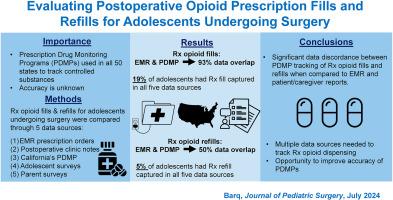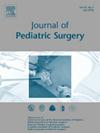Evaluating Postoperative Opioid Prescription Fills and Refills for Adolescents Undergoing Surgery
IF 2.4
2区 医学
Q1 PEDIATRICS
引用次数: 0
Abstract
Introduction
Prescription drug monitoring programs (PDMPs) are state-run databases that track controlled substances to reduce substance use and diversion. The accuracy of PDMPs for adolescents who receive postoperative opioid prescriptions is unknown.
Methods
This prospective cohort study was conducted at a free-standing tertiary children’s hospital from 2019 to 2020. Adolescents 13-20 y undergoing elective surgery commonly associated with an opioid prescription at discharge were enrolled. Prescription opioid fills and refills were measured through five data sources: (1) Electronic Medical Record (EMR) prescription orders (2) postoperative clinic notes, (3) California’s PDMP and (4) adolescent and (5) parent surveys. UpSet plots were used to visualize and quantify data overlap between sources.
Results
The majority of the 55 adolescents enrolled were Hispanic/Latino (52.7%), female (54.5%), and underwent posterior spinal fusion (41.8%). Of 42 adolescents with an opioid prescription in the EMR, the greatest overlap in data sources occurred between the EMR and PDMP (92.9%) with only 19% of adolescents having their opioid prescription fill captured in all five data sources. Two patients (3.6%) who did not receive an opioid prescription based on EMR or survey data were identified in the PDMP. Survey data indicated that eight adolescents (19.0%) refilled their opioid prescription. However, the PDMP only captured four (9.5%) refills.
Conclusion
Discrepancies exist among EMR, PDMP, and survey documentation of prescription opioid dispensing and refills for adolescents undergoing surgery. These findings highlight the need to capture multiple data sources when tracking prescription opioid dispensing. Additionally, there is opportunity for improved accuracy within prescription drug monitoring programs.
Type of Study
Prospective Cohort Study.
Level of Evidence
Level 4.

评估接受手术的青少年术后阿片类药物处方的开具和续订情况
导言处方药监控计划(PDMP)是由州政府管理的数据库,用于追踪受管制药物,以减少药物使用和转移。这项前瞻性队列研究于 2019 年至 2020 年在一家独立的三级儿童医院进行。13-20 岁的青少年接受了通常与出院时阿片类药物处方相关的择期手术。阿片类药物处方的填写和重新填写通过五个数据源进行测量:(1)电子病历(EMR)处方单;(2)术后门诊记录;(3)加利福尼亚州 PDMP;(4)青少年调查;(5)家长调查。结果55名参加调查的青少年中,大多数为西班牙裔/拉丁裔(52.7%)、女性(54.5%),并接受了脊柱后路融合术(41.8%)。在 EMR 中有阿片类药物处方的 42 名青少年中,EMR 和 PDMP(92.9%)之间的数据源重叠最多,只有 19% 的青少年的阿片类药物处方在所有五个数据源中都有记录。根据 EMR 或调查数据,有两名患者(3.6%)未在 PDMP 中获得阿片类药物处方。调查数据显示,有 8 名青少年(19.0%)重新开具了阿片类药物处方。结论对于接受手术的青少年,EMR、PDMP 和调查中关于阿片类药物处方配药和重新配药的记录存在差异。这些发现凸显了在跟踪阿片类处方配药时获取多种数据源的必要性。此外,处方药监控计划的准确性也有提高的空间。
本文章由计算机程序翻译,如有差异,请以英文原文为准。
求助全文
约1分钟内获得全文
求助全文
来源期刊
CiteScore
1.10
自引率
12.50%
发文量
569
审稿时长
38 days
期刊介绍:
The journal presents original contributions as well as a complete international abstracts section and other special departments to provide the most current source of information and references in pediatric surgery. The journal is based on the need to improve the surgical care of infants and children, not only through advances in physiology, pathology and surgical techniques, but also by attention to the unique emotional and physical needs of the young patient.

 求助内容:
求助内容: 应助结果提醒方式:
应助结果提醒方式:


